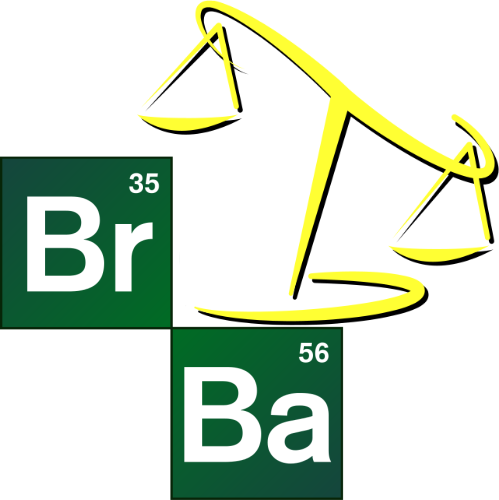- This article is about the TV series. For other uses, see Breaking Bad.
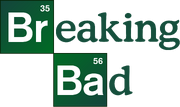
Breaking Bad is an American crime drama television series created and produced by Vince Gilligan. Set and filmed in Albuquerque, New Mexico, the series follows Walter White (Bryan Cranston), an underpaid, overqualified, and dispirited high-school chemistry teacher who is struggling with a recent diagnosis of stage-three lung cancer. Walt turns to a life of crime and partners with a former student, Jesse Pinkman (Aaron Paul), to produce and distribute crystal meth to secure his family's financial future before he dies, while navigating the dangers of the criminal underworld. The show aired on AMC from January 20, 2008, to September 29, 2013, consisting of five seasons for a total of 62 episodes.
Among the show's co-stars are Anna Gunn and RJ Mitte as Walter's wife Skyler and son Walter Jr., and Betsy Brandt and Dean Norris as Skyler's sister Marie Schrader and her husband Hank, a DEA agent. Others include Bob Odenkirk as Walter's and Jesse's sleazy lawyer Saul Goodman, Jonathan Banks as private investigator and fixer Mike Ehrmantraut, and Giancarlo Esposito as drug kingpin Gustavo Fring. The final season introduces Jesse Plemons as the criminally ambitious Todd Alquist, and Laura Fraser as Lydia Rodarte-Quayle, a cunning business executive secretly managing Walter's global meth sales for her company.
Breaking Bad's first season received generally positive reviews, while the rest of its run received unanimous critical acclaim. Since its conclusion, the show has been lauded by critics as one of the greatest television series of all time. It had fair viewership in its first three seasons, but the fourth and fifth seasons saw a moderate rise in viewership when it was made available on Netflix just before the fourth season premiere. Viewership increased more drastically upon the premiere of the second half of the fifth season in 2013. By the time that the series finale aired, it was among the most-watched cable shows on American television. The show received numerous awards, including 16 Primetime Emmy Awards, eight Satellite Awards, two Golden Globe Awards, two Peabody Awards, two Critics' Choice Awards, and four Television Critics Association Awards. Cranston won the Primetime Emmy Award for Outstanding Lead Actor in a Drama Series four times, while Aaron Paul won the Primetime Emmy Award for Outstanding Supporting Actor in a Drama Series three times; Anna Gunn won the Primetime Emmy Award for Outstanding Supporting Actress in a Drama Series twice. In 2013, Breaking Bad entered the Guinness World Records as the most critically acclaimed TV show of all-time.
The series gave rise to the larger Breaking Bad Franchise. A sequel film, El Camino: A Breaking Bad Movie, was released on October 11, 2019, which wrapped up Jesse's story. Better Call Saul, a prequel and occasional sequel series featuring Odenkirk, Banks, and Esposito reprising their Breaking Bad roles, as well as many others in guest and recurring appearances, debuted on February 8, 2015, and finished airing its sixth and final season on August 15, 2022.
Production[]
Conception[]

Vince Gilligan and Bryan Cranston on the set of "Pilot" in 2007
Breaking Bad was created by Vince Gilligan, who spent several years writing the Fox series The X-Files. Gilligan wanted to create a series in which the protagonist became the antagonist. "Television is historically good at keeping its characters in a self-imposed stasis so that shows can go on for years or even decades," he said. "When I realized this, the logical next step was to think, how can I do a show in which the fundamental drive is toward change?" He added that his goal with Walter White was to turn him from Mr. Chips into Scarface. Gilligan believed the concept of showing the full drastic transformation of a character across the run of a television show was a risky concept and would be difficult to pitch without other powerful factors to support it, such as strong cinematography and acting.
The show's title is a Southern colloquialism meaning, among other things, "raising hell", and was chosen by Gilligan to describe Walter's transformation. According to Time entertainment editor Lily Rothman, the term has a broader meaning and is an old phrase which "connotes more violence than 'raising hell' does ... [T]he words possess a wide variety of nuances: to 'break bad' can mean to 'go wild', to 'defy authority', and break the law, to be verbally 'combative, belligerent, or threatening' or, followed by the preposition 'on', 'to dominate or humiliate'."
The concept emerged as Gilligan talked with his fellow X-Files writer Thomas Schnauz regarding their current unemployment and joked that the solution was for them to put a "meth lab in the back of an RV and [drive] around the country cooking meth and making money".
After writing the concept for the show and pilot, Gilligan pitched it to Sony Pictures Television, who became very interested in supporting it. Sony arranged for meetings with the various cable networks. Showtime passed on this, as they had already started broadcasting Weeds, a show with similarities to the premise of Breaking Bad. While his producers convinced him that the show was different enough to still be successful, Gilligan later stated that he would not have gone forward with the idea had he known about Weeds earlier. Other networks like HBO and TNT also passed on the idea, but eventually FX took interest and began initial discussions on producing the pilot. At the same time, FX had also started development of Dirt, a female-centric crime-based drama series, and with three existing male-centric shows already on the network, FX passed up Breaking Bad for Dirt.
One of Gilligan's agents spoke to Jeremy Elice, the director of original programming for AMC who was looking for more original shows to add alongside their upcoming Mad Men. Elice was intrigued, and soon a meeting was set up between Gilligan, Elice, and two programming executives. Gilligan was not optimistic about this meeting, fearing they would just put him off, but instead all three showed great interest, and the meeting ended up establishing how AMC would acquire the rights from FX and set the pilot into production. It took about a year following this meeting before Sony had set up the rights with AMC and production could start.
Development history[]
The network ordered nine episodes for the first season (including the pilot), but the 2007–08 Writers Guild of America strike limited the production to seven episodes, as well as delaying the start of production for the second season. Within the original nine-episode arc, Gilligan had planned to kill off Jesse or Hank, as a "ballsy" moment to end the season on. This death was eliminated with the limited episode count, which Gilligan found to be a net positive given the strength of acting that both Paul and Norris brought to these roles through the seasons. The strike also helped to slow down production long enough for Gilligan and his writing team to readjust the pacing of the show, which in the original arc had been moving too quickly. Gould stated that the writer's strike "saved the show", as if they had produced the two additional episodes in the first season, they would have gone down a different creative path that he believes would have led to the show's cancellation by its third season.
The initial versions of the script were set in Riverside, California, but at the suggestion of Sony, Albuquerque was chosen for the production's location due to the favorable financial conditions offered by the state of New Mexico. Once Gilligan recognized that this would mean "we'd always have to be avoiding the Sandia Mountains" in shots directed toward the east, the story setting was changed to the actual production location. It was shot primarily on 35 mm film, with digital cameras employed as needed for additional angles, point of view shots and time-lapse photography. Breaking Bad cost $3 million per episode to produce, higher than the average cost for a basic cable program.
Around 2010, AMC had expressed to Sony Pictures Television and Gilligan that they felt that the third season would be the last for Breaking Bad. Sony started to shop the show around, having gained quick interest from the FX network for two more seasons, upon which AMC changed its mind and allowed the show to continue. At the same time, Netflix was starting to aggressively shop for content to add to its service, and arranged a deal with Sony for Breaking Bad to be available after the airing of the fourth season. However, knowing that AMC had placed Breaking Bad on a potential cancellation route, Sony pushed to have the show added to the service in time for the fourth season. Because of this, Breaking Bad's viewership grew greatly as viewers binged the series on Netflix, helping to assure that a fifth season could be made. The fifth-season premiere had more than double the viewership compared to the fourth season premiere, attributed to the Netflix availability. Gilligan thanked Netflix at the Emmy Awards in September 2013 after the series' conclusion for the popularity of the series, saying that Netflix "kept us on the air".
As the series progressed, Gilligan and the writing staff of Breaking Bad made Walter increasingly unsympathetic. Gilligan said during the run of the series, "He's going from being a protagonist to an antagonist. We want to make people question who they're pulling for, and why." Cranston said by the fourth season, "I think Walt's figured out it's better to be a pursuer than the pursued. He's well on his way to badass."
In July 2011, Vince Gilligan indicated that he intended to conclude Breaking Bad at the end of its fifth season. In early August 2011, negotiations began over a deal regarding the fifth and possible final season between the network AMC and Sony Pictures Television, the production company of the series. AMC proposed a shortened fifth season (six to eight episodes, instead of 13) to cut costs, but the producers declined. Sony then approached other cable networks about possibly picking up the show if a deal could not be made. On August 14, 2011, AMC renewed the series for a fifth and final season consisting of 16 episodes. However, in April 2012, Bryan Cranston revealed that the fifth season would be split into two halves, with the first eight episodes airing in 2012, and the final eight in 2013.
Before the series finale, Gilligan said that it was difficult to write for Walter White because the character was so dark and morally questionable: "I'm going to miss the show when it's over, but on some level, it'll be a relief to not have Walt in my head anymore." Gilligan later said the idea for Walter's character intrigued him so much that he "didn't really give much thought on how well it would sell", stating that he would have given up on the premise since it was "such an odd, dark story" that could have difficulties being pitched to studios. Ultimately, Gilligan chose to end Breaking Bad with Walter's death, occurring in-story two years after he had first been diagnosed with cancer and given two years to live. Gilligan said by the end of the series, "it feels as if we should adhere to our promise that we explicitly made to our audience" from the first episode.
Casting[]
- "You're going to see that underlying humanity, even when he's making the most devious, terrible decisions, and you need someone who has that humanity – deep down, bedrock humanity – so you say, watching this show, 'All right, I'll go for this ride. I don't like what he's doing, but I understand, and I'll go with it for as far as it goes.' If you don't have a guy who gives you that, despite the greatest acting chops in the world, the show is not going to succeed. "
- ―Vince Gilligan, about Bryan Cranston
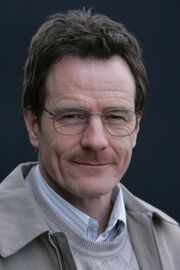
Walter White (Bryan Cranston) as he appears in the early episodes of the first season, prior to shaving his head. Cranston previously worked with Vince Gilligan on The X-Files, leading to him landing the role of Walt.
Breaking Bad creator Vince Gilligan cast Bryan Cranston for the role of Walter White based on having worked with him in the "Drive" episode of the science fiction television series The X-Files, on which Gilligan worked as a writer. Cranston played an anti-Semite with a terminal illness who took series co-protagonist Fox Mulder (David Duchovny) hostage. Gilligan said the character had to be simultaneously loathsome and sympathetic, and that "Bryan alone was the only actor who could do that, who could pull off that trick. And it is a trick. I have no idea how he does it." AMC officials, who were initially reluctant with the casting choice, having known Cranston only as the over-the-top character Hal on the comedy series Malcolm in the Middle, approached actors John Cusack and Matthew Broderick about the role. When both actors declined, the executives were persuaded to cast Cranston after seeing his X-Files episode.
Cranston contributed significantly to the formation and development of the Walter White persona. When Gilligan left much of Walter's past unexplained during the development of the series, the actor wrote his own backstory for the character. At the start of the show, Cranston gained 10 pounds to reflect the character's personal decline, and had the natural red highlights of his hair dyed brown. He collaborated with costume designer Kathleen Detoro on a wardrobe of mostly neutral green and brown colors to make the character bland and unremarkable, and worked with makeup artist Frieda Valenzuela to create a mustache he described as "impotent" and like a "dead caterpillar". Cranston repeatedly identified elements in certain scripts where he disagreed with how the character was handled, and went so far as to call Gilligan directly when he could not work out disagreements with the episode's screenwriters. Cranston has said he was inspired partially by his elderly father for how Walter carries himself physically, which he described as "a little hunched over, never erect, [as if] the weight of the world is on this man's shoulders." In contrast to his character, Cranston has been described as extremely playful on set, with Aaron Paul describing him as "a kid trapped in a man's body".

Cast photo from the first half of the fifth and final season, showcasing all the main characters in that season, and all but three of the main characters in the series overall.
Aaron Paul's casting as Walt's meth cook partner and former student Jesse Pinkman was also initially questioned by production, as Paul looked too old and too much like a "pretty boy" to be associated with meth cooking. However, Gilligan reconsidered Paul's skills after seeing his audition and recalling he had also had guest starred on The X-Files episode "Lord of the Flies". Gilligan originally intended for Jesse to be killed at the end of Breaking Bad's first season in a botched drug deal as a plot device to plague Walter White with guilt. However, Gilligan said by the second episode of the season, he was so impressed with Paul's performance that "it became pretty clear early on that would be a huge, colossal mistake, to kill off Jesse". Similarly, Dean Norris had shown his ability to be a law enforcement official in The X-Files episode "F. Emasculata", and was brought on to be Hank Schrader, Walter's brother-in-law and DEA agent.
Scientific accuracy[]
- "Dr. Donna Nelson from the University of Oklahoma approached us several seasons back and said, "I really like this show, and if you ever need help with the chemistry, I'd love to lend a hand." She's been a wonderful advisor. We get help wherever we need it, whether it's chemistry, electrical engineering, or physics. We try to get everything correct. There's no full-time [advisor] on set, but we run certain scenes by these experts first."
- ―Vince Gilligan
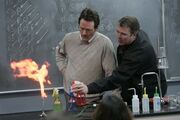
Cranston and Gilligan filming the scene where Walt gives a chemistry lesson in the show's pilot episode.
Donna Nelson, a professor of organic chemistry at the University of Oklahoma, checked scripts and provided dialogue. She also drew chemical structures and wrote chemical equations which were used as props. According to creator Vince Gilligan, "Because Walter White was talking to his students, I was able to dumb down certain moments of description and dialogue in the early episodes which held me until we had some help from some honest-to-God chemists.". According to Gilligan, Nelson "vets our scripts to make sure our chemistry dialogue is accurate and up to date. We also have a chemist with the Drug Enforcement Administration based out of Dallas who has just been hugely helpful to us." Nelson spoke of Gilligan's interest in having the science right, saying that Gilligan "said it made a difference to him."
Several episodes of Mythbusters featured attempts to validate or disprove scenes from Breaking Bad, often with Gilligan guest-starring in the episode to participate. In 2013, two scenes from the first season of Breaking Bad were put under scrutiny in a Mythbusters Breaking Bad special. Despite several modifications to what was seen in the show, both the scenes depicted in the show were shown to be physically impossible. It was shown impossible to use hydrofluoric acid to fully dissolve metal, flesh, or ceramic as shown in the episode "Cat's in the Bag...", and that while it was possible to throw fulminated mercury against the floor to cause an explosion, as in the episode "Crazy Handful of Nothin'", Walter would have needed a much larger quantity of the compound and thrown at a much faster speed, and likely would have killed all in the room. A later Mythbusters episode, "Blow It Out of the Water", tested the possibility of mounting an automated machine gun in a car as in the series finale "Felina", and found it plausible. An episode of MythBusters Jr. proved that it was impossible for an electromagnet to draw metallic objects from across a room as in the episode "Live Free or Die".
Jason Wallach of Vice magazine commended the accuracy of the cooking methods presented in the series. In early episodes, a once-common clandestine method, the Nagai red phosphorus/iodinemethod, is depicted, which uses pseudoephedrine as a precursor to d-(+)-methamphetamine. By the season 1 finale, Walt chooses to use a different synthetic route based on the difficulty of acquiring enough pseudoephedrine to produce on the larger scale required. The new method Walt chooses is a reductive amination reaction, relying on phenyl-2-propanone and methylamine. On the show, the phenyl-2-propanone (otherwise known as phenylacetone or P2P) is produced from phenylacetic acid and acetic acid using a tube furnace and thorium dioxide (ThO2) as a catalyst, as mentioned in episodes "A No Rough-Stuff-Type Deal" and "Más". P2P and methylamine form an imine intermediate; reduction of this P2P-methylamine imine intermediate is performed using mercury aluminum amalgam, as shown in several episodes, including "Hazard Pay".
Technical aspects[]
Michael Slovis was the cinematographer of Breaking Bad, beginning with the second season, and he received critical acclaim for his work throughout the series. Critics appreciated the bold visual style adopted by the TV series. Although series creator Vince Gilligan and Slovis wanted to shoot Breaking Bad in CinemaScope, Sony and AMC did not grant them permission. Gilligan cited Sergio Leone's Westerns as a reference for how he wanted the series to look. Slovis received four Primetime Emmy Award nominations for Outstanding Cinematography for a One Hour Series and Outstanding Cinematography for a Single-Camera Series.
Breaking Bad was shot on 35 mm movie film because of the robustness of the equipment and to keep a focus on shooting scenes economically. It also allowed for a later digital transfer to 4K Ultra HD resolution. By the end of the fifth season, episodes had cost upwards of US$6 million to produce.
Kelley Dixon was one of the few editors of Breaking Bad and edited many of the series' "meth montages". For the montages, she would use techniques such as jump cuts and alternating the speed of the film, either faster or slower. For her work, she received six Primetime Emmy Award nominations for Outstanding Single-Camera Picture Editing for a Drama Series and won the award in 2013.
Episodes[]
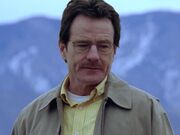
Season 1 (2008)[]
Walter, diagnosed with inoperable lung cancer, conspires with Jesse to cook crystal meth as a way to pay for his treatment and provide financial security for his family. Jesse secures an R.V. to cook in, while Walter devises a revolutionary formula using unregulated chemicals, creating a highly pure product tinted blue. After a run-in with the Mexican drug cartel, Walter adopts the nickname "Heisenberg" and trades his "blue sky" meth with psychotic drug lord Tuco Salamanca. Hank and the DEA become aware of this new figure in the drug trade and begin their investigations.

Season 2 (2009)[]
Tuco and Walter become hostile to one another and Tuco is killed by Hank. Walter hires corrupt lawyer Saul Goodman, who later connects them to high-profile drug distributor Gus Fring and hitman Mike Ehrmantraut. Jesse dates his apartment manager Jane, who introduces him to heroin, making him unreliable. Walter refuses to pay Jesse's half of the sale to Gus, but Jane blackmails Walter. Walter returns to Jesse to apologize, but instead allows an unconscious Jane to choke on her own vomit. Jesse, traumatised, enters rehab. Walter seems content with life until he witnesses a mid-air collision of two planes, a result of Jane's father, an air-traffic controller, becoming distraught over her death while on the job.
Season 3 (2010)[]

Skyler learns of Walter's crimes and demands a divorce, so he retires from the drug trade briefly, but Gus offers him a job cooking meth at a state-of-the-art hidden lab with an assistant, Gale. Hank's investigation leads him to Jesse; he finds no evidence, but violently assaults him and is suspended from the DEA. Walt, in order to keep Jesse from suing Hank for the assault, coerces Gus into replacing Gale with Jesse as lab assistant. Hank is attacked by Tuco's vengeful cousins and kills them, becoming paralysed in the aftermath. Jesse's behaviour becomes erratic, and Walter is forced to kill two of Gus' drug dealers to protect Jesse. After an enraged Gus orders Walter and Jesse killed, Jesse kills Gale so Gus cannot replace them as a cook for meth.
Season 4 (2011)[]
Gus tightens security at the lab after Gale's death. Gus and Mike work to drive a wedge between Walter and Jesse, seeking to coerce Jesse to be their solitary cook by capturing Walter while at the same time eliminating the Mexican cartel. Skyler accepts Walter's meth cooking, and works with Saul to launder his earnings. Hank, while recovering, tracks Gale's death to Gus and the drug trade. Gus releases Walter and plans to kill Hank. Walter tricks Jesse into turning against Gus, and convinces Hector Salamanca, the last living member of the cartel, to detonate a bomb while meeting with Gus, killing them both.
Season 5 (2012–13)[]

On August 14, 2011, AMC announced that Breaking Bad was renewed for a fifth and final season consisting of 16 episodes. Season five is split into two parts, each consisting of 8 episodes. The first half premiered on July 15, 2012, while the second half premiered on August 11, 2013. In August 2013, AMC released a trailer promoting the premiere of final season with Bryan Cranston reading the poem "Ozymandias" by Percy Bysshe Shelley, over timelapse shots of Breaking Bad locations.
After Gus' death, Walter, Jesse, and Mike start a new meth business. When their accomplice Todd kills a child witness during their theft of methylamine, Jesse and Mike sell their share of the methylamine to Declan, another distributor. Walter produces meth for Declan, and Gus' former associate Lydia starts distribution in Europe, which is so successful that Walter earns US$80 million, which he buries on the Tohajiilee Indian Reservation. After Walter kills Mike during an argument, he gets the list of Mike's imprisoned men from Lydia, and hires Todd's uncle Jack and his gang to kill Mike's associates and Jesse. Hank discovers Walter is Heisenberg and begins gathering evidence, and turns to Jesse, who helps locate Walter's money in the desert. During a desert showdown between Walter and Hank and his partner Steve, Jack's gang arrives. They turn on Walter, kill Hank and Steve, capture Jesse, and take most of Walter's money, leaving him just one of the seven barrels. Walter uses this to escape to New Hampshire.
After months in hiding, Walter intends to surrender, but changes course after Elliott and Gretchen publicly minimize his involvement in starting Gray Matter. Walt forces Elliott and Gretchen to give the money to Walter Jr. once he turns 18. After poisoning Lydia, Walt admits to Skyler that he manufactured meth for his own satisfaction rather than for his family. At Jack's compound, Walter kills Jack and the rest of his gang with a remote-activated machine gun turret and frees Jesse, who kills Todd. Wounded by his own machine gun, Walter asks Jesse to kill him, but Jesse refuses. The two share a farewell glance, after which Jesse escapes. Walter dies from his wounds in Jack's meth lab.
Seasons[]
- See the list of all episodes from all five seasons.
Awards and nominations[]

Cranston and Paul with their 2010 Emmy awards
The series received numerous awards and nominations, including 16 Primetime Emmy Awards and 58 nominations, including winning for Outstanding Drama Series in 2013 and 2014. It also won two Peabody Awards, one in 2008 and one in 2013.
For his portrayal of Walter White, Bryan Cranston won the Primetime Emmy Award for Outstanding Lead Actor in a Drama Series four times, in 2008, 2009, 2010, and 2014. Cranston also won the TCA Award for Individual Achievement in Drama in 2009 and the Satellite Award for Best Actor – Television Series: Drama in 2008, 2009, and 2010, as well as the Critics' Choice Television Award for Best Actor in a Drama Series and the Saturn Award for Best Actor on Television in 2012.
Aaron Paul won the Primetime Emmy Award for Outstanding Supporting Actor in a Drama Series in 2010, 2012, and 2014. Paul also won the Saturn Award for Best Supporting Actor on Televisionin 2010 and 2012. Anna Gunn won the Primetime Emmy Award for Outstanding Supporting Actress in a Drama Series in 2013 and 2014. For his work on season four, Giancarlo Esposito won the Critics' Choice Television Award for Best Supporting Actor in a Drama Series.
In 2010 and 2012, Breaking Bad won the TCA Award for Outstanding Achievement in Drama, as well as the TCA Award for Program of the Year in 2013. In 2009 and 2010, the series won the Satellite Award for Best Television Series – Drama, along with the Saturn Award for Best Syndicated/Cable Television Series in 2010, 2011, and 2012. The series won the Writers Guild of America Award for Television: Dramatic Series in both 2012 and 2013. In 2013, it was named No. 13 in a list of the 101 Best-Written TV Series of All Time by the Writers Guild of America and won, for the first time, the Primetime Emmy Award for Outstanding Drama Series. Overall, the show has won 110 industry awards and been nominated for 262.
Ratings[]
The first season averaged 1.2 million viewers. The second season premiere was watched by 1.7 million viewers, up 41.6% from the previous season.
The third season premiere was the highest rated episode in the series' history at that time; having been watched by 2 million viewers, with an additional 1.1 million viewers with the repeat airings later the same night, increasing 40% from the second season premiere. The rest of the third season episodes averaged between 1.2 and 1.8 million viewers.
The fourth season premiere received 2.6 million viewers, increasing 32% from the third season premiere. The fifth season premiere received 2.9 million viewers, ranking it as the most-watched premiere of the series. Viewership jumped 102% for the midseason premiere when 5.9 million people tuned in for "Blood Money". The third-to-final episode "Ozymandias," also referred to by Vince Gilligan as "the best episode we ever had had or ever will have"[1] was watched by 6.4 million viewers.[2] The penultimate episode "Granite State" continued the trend and was watched by 6.58 million viewers. The series finale "Felina" blew away the previous episode's record and was watched by 10.3 million viewers when it aired on September 29, 2013.[3]
